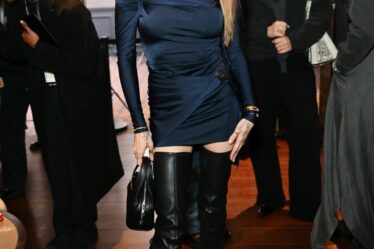
Right now, candidates who have never worked in fashion are interviewing for jobs where they’d be key decision makers at Burberry, Capri Holdings, Farfetch and other big brands.
The candidates are graduates of The Outsider’s Perspective, an incubator launched by former Roksanda chief executive Jamie Gill for people of colour who want to break into the fashion industry. The programme, backed by Burberry, Zalando and Deloitte, offers workshops and face time with executives and human resources directors from major fashion companies (like Lululemon, Burberry and Farfetch) and tech giants like Meta that have signalled interest in expanding their candidate pool beyond the traditional fashion resumé.
While racial diversity is the incubator’s hook, its larger purpose is to challenge the industry’s often narrow view of recruitment and demonstrate the advantages of bringing a different perspective to operational areas, such as human resources, marketing, operations, digital and finance. All participants have at least five years professional experience in industries such as finance and consulting.
“This is a clear path for innovation in leadership and it’s bringing fresh perspectives to the table,” Gill said.
Fashion has long had a reputation for being an insular industry. When Gucci recruited Robert Polet, then Unilever’s head of frozen foods, to be its CEO in 2004, The Independent cast the decision to appoint the “ice cream man” as a slap in the face to the luxury world. Standards have changed in the years since: Ralph Lauren hired Patrice Louvet, who spent nearly three decades at Procter & Gamble, to lead its business in 2017; Chanel’s CEO was previously head of human resources at Unilever, and Under Armour’s came from the hotel industry.
These days, a resumé heavy on experience outside the fashion world is increasingly seen as a plus, whether it’s the CEO, a mid-level manager or in some cases, a store associate or manager.
That reflects sweeping changes in the business, including the rise of e-commerce and the global nature of supply chains and distribution networks. Companies also need employees with expertise in areas like climate change and diversity where fashion hasn’t historically been a leader.
“The message at the end of the day is: if you’re only going to play in your pool, there’s a high likelihood that if you’re looking for change, it might not come,” said Caroline Pill, partner at executive search consultancy Heidrick & Struggles’ London office, focused on the global fashion, luxury and beauty industries.
When to Recruit From Outside the Industry
There are certain business areas — marketing, supply chain and technology, among them — where bringing in an outsider makes the most sense, said Craig Rowley, senior client partner at Korn Ferry.
Generally, people who work in operational functions such as finance, supply chain, human resources, and marketing tend to have many transferable skills that work across industries and therefore offer the most opportunities for success when it comes to cross pollination, Rowley said. For instance, a person who has experience operating complicated supply chain networks, handling perishable materials and distributing large volumes can be an asset to any kind of business whether they’re moving clothes, furniture or canned goods, experts say.
“Retailers have to have state of the art technology and know how to integrate that with a customer — so they have to go to areas like CPG where that knowledge is deeper,” Rowley said.
The general rule, however, is that those in product and creative roles fare best if they have a more traditional fashion resume, Pill said.
“If you’re looking at a product role or a CEO who needs to work with a creative director, then it becomes more difficult [to make it work] with an outsider,” she said.
Before onboarding an industry newcomer, particularly at management and C-suite levels, a company should determine whether they’re in need of organisational overhaul or simply looking for a fresh perspective in day-to-day business conversations, Rowley said.
If a company is bringing in a change agent, “there needs to be buy-in from the top,” and the company needs to “be very clear on the time frame” during which it expects to create the change, said Janou Pakter, partner of Burō Talent, a creative and marketing executive search agency.
“It’s not just a knee jerk thing where a person is hired and you flip a switch and the company is [better],” said Damian Chiam, a partner at Burō. “If the organisation, culturally, is a dinosaur and it takes forever to change, you have to give it that runway.”
The Minimum Common Denominator
Fashion companies and job candidates always need “a minimum common denominator,” — core values and passions they share, said Pill. This is doubly true when they don’t have a design background or a knowledge of fashion history in common.
“The person that comes in has to respect and value the heritage and the DNA of the brand,” said Pakter. “If you come in and right away and you’re like ‘we can do this much better and we have to change,’ … that’s very dangerous.”
For candidates, soft skills like adaptability, agility, good communication and listening, plus a high level of curiosity are all important, said Pill. Other capabilities, like change management, strategic analysis and speed as well as familiarity with functions like marketing and technology tend to be attractive to fashion firms, said Rowley.
How jarring (or seamless) the transition is can vary depending on specifics in the candidate’s background. If someone comes from CPG, for instance, they would need to adjust to fashion’s higher volume and more seasonal business, Rowley said. A person entering fashion from tech may need to wrap their head around small margins and tighter budgets, he noted.
To ensure they’ve found a “culture fit,” fashion firms should take their recruitment beyond run-of-the-mill job boards and standard interviews, said Pakter, and create a more personalised approach to screening outsiders.
“All of these tests and interviews are so meaningless compared to taking somebody out and having dinner with them,” she said. “Bring him or her to social settings, get to know them by asking real questions.”
With economic downturn potentially on the horizon, the payoff from diversifying fashion’s workforce and bringing new perspectives to the c-suite could become greater in the next few months, said Gill.
“In turbulent times, the argument for that outside skill set and fresh perspective is [stronger],” he said. “To be able to pivot and understand what your business strength is, why not hear from a banker or a lawyer or someone who is coming at this from a different lens?”



